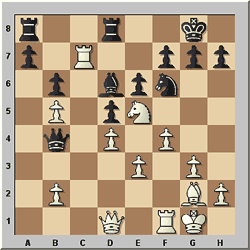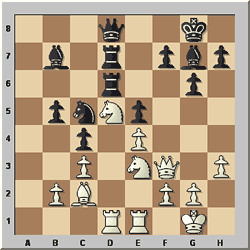
Round four
Round 4: Wednesday, February 21st |
Peter Leko |
½-½ |
Levon Aronian |
Vishy Anand |
1-0 |
Alex. Morozevich |
Vassily Ivanchuk |
0-1 |
Magnus Carlsen |
Veselin Topalov |
½-½ |
Peter Svidler |
|
|
Round 5: Thursday, February 22nd |
Peter Svidler |
|
Peter Leko |
Magnus Carlsen |
|
Veselin Topalov |
Alex. Morozevich |
|
Vassily Ivanchuk |
Levon Aronian |
|
Vishy Anand |
Games – Report |
|
Standings after four rounds
Commentary by GM Mihail Marin
The following express commentary was provided by Romanian GM Mihail Marin,
who is the author of a number of very popular ChessBase training CDs and articles
for ChessBase Magazine. GM Marin will study the games of the Morelia/Linares
tournament in greater detail and provide the full results of his analysis in
the next issue of ChessBase
Magazine.

Topalov,V (2783) - Svidler,P (2728) [A16]
XXIV SuperGM Morelia/Linares MEX/ESP (4), 21.02.2007 [Mihail Marin]
1.Nf3 Nf6 2.c4 g6 3.Nc3 d5 4.Qa4+ Bd7 5.Qb3 dxc4 6.Qxc4 a6 7.d4 b5 8.Qb3
c5 9.dxc5 Bg7 10.e4 0-0 11.Be2 Bc6 12.e5 Nfd7 13.Be3 Nxe5 14.Nxe5 Bxe5.
15.Rd1. Topalov deviates from 15.0-0 as played in the game Gelfand-Svidler,
Moscow 2006, which was eventually won by White.
15...Qa5 16.0-0 e6 17.f4 Bg7
18.a3 Qc7 19.Qc2 b4!? The only way to prevent b2-b4.
20.axb4 Qb7 21.Rd6
Qxb4 22.Rfd1 Ra7 23.R1d2 Rd7 24.Rxd7 Nxd7 25.Rd6 Qb7.
In spite of White's activity, Black can maintain his stability on light squares
without problems. 26.Qd2 Nf6 27.Bf1 Rb8 28.Rd8+ Bf8 29.Rxb8 1/2-1/2. [Click
to replay]

Leko,P (2749) - Aronian,L (2744) [E06]
XXIV SuperGM Morelia/Linares MEX/ESP (4), 21.02.2007 [Mihail Marin]
1.d4 Nf6 2.c4 e6 3.Nf3 d5 4.g3 Bb4+ 5.Bd2 Be7 6.Bg2 0-0 7.0-0 c6 8.Bf4 b6
9.Nc3 Bb7
10.Rc1!? A relatively rare setup. White aims for rapid piece development,
in the hope of occupying the c-file.
10...Nh5 11.Bxb8 Qxb8 12.Ne5 Nf6 13.e3
Rd8 14.cxd5 cxd5 15.f4 Qd6. A novelty. Black activates his queen, in order
to put the enemy queenside under pressure. After 15...g6 16.g4 Nd7 17.Qe1 a draw
was agreed in Khalifman-Adams, Cesme 2004, but White seems to have a promissing
attacking position.
16.Nb5 Qb4 17.Rc7 Ba6 18.a4 Bxb5 19.axb5 Bd6
20.Rxf7!? An interesting and almost forced attacking continuation, which,
however, fails to endanger Black's king.
20...Bxe5 21.fxe5 Kxf7 22.Qh5+ Kg8
23.exf6 gxf6 24.Qg4+ Kh8. Reaching absolute safety. 24...Kf7?! 25.Qh4 would
leave White with the initiative.
25.Qxe6 Rf8 26.Qxd5 Rae8 White's initiative
has been extinguished and he faces some problems now. With a better structure
(a pawn on f2 instead of h2, for instance) he would most likely be better, but
the e3-pawn is weak now and the king slightly exposed.
27.Rf3 Qe1+ 28.Bf1 Rxe3
29.Qd6 Ree8 30.Rxf6 Kg7 31.Rxf8 Rxf8
Apparently, White is in big trouble.
32.Qe5+ The saving move. After the
exchange of queens, White will build a reliable fortress, something that is not
easy to foresee.
32...Qxe5 33.dxe5 Re8 34.Bc4 Rxe5 35.Kf2 Kf6 36.b3 Re4 37.Bd3
Re7 38.Kf3 h6 39.Kg4 Re5 40.Bc4 Rc5 41.Kf4 Rf5+ 42.Ke4 Rf2 43.h4 Rd2 44.Ke3 Rd8
45.Ke4 Rd1 46.Bd5.
If Black transfers his king to the queenside, White will simply crate a passed
pawn on the other wing. 1/2-1/2. [Click
to replay]

Anand,V (2779) - Morozevich,A (2741) [C95]
XXIV SuperGM Morelia/Linares MEX/ESP (4), 21.02.2007 [Mihail Marin]
1.e4 e5 2.Nf3 Nc6 3.Bb5 a6 4.Ba4 Nf6 5.0-0 Be7 6.Re1 b5 7.Bb3 d6 8.c3 0-0 9.h3
Nb8 The Breyer system has become fashionable lately, but this is precisely
the reason why Morozevich' choice might seem a bit surprising. The Russian GM
usually prefer to play his "own theory". 10.d4 Nbd7 11.Nbd2 Bb7
12.Bc2 Re8 13.Nf1 Bf8 14.Ng3.
14...c6!? Of course. Instead of the almost authomatically played 14...g6
, Morozevich employs a move that has been played only once, 51 (!) years ago.
15.Nf5 Qc7. The old game lost its theoretical significance after 15...g6?
16.Nh6+ Bxh6
(Sad necessity. If
16...Kg7 then
17.Ng5! and
the f7-pawn is impossible to defend, for instance
17...Re7 18.Nhxf7 and
the knight is taboo because of the fork on e6.
) 17.Bxh6 . After giving
up his bishop, Black had an awful position in Burstein-Thomson, Moscow ol 1956.
16.dxe5 dxe5 17.Nh2 c5 18.Qf3 c4 Black clears the c5-square for his queen's
knight. With his next moves, White will put pressure on the f6-square, in order
to take advantage of the predictable departure of the knight from d7.
19.Bg5
Re6 20.Rad1 Nc5 21.Bxf6 Rxf6 22.Ng4 Re6 23.Nge3 Qa5 24.a3 g6.
Black enjoys almost absolute stability on dark squares, while White's activity
has a temporary character. We can conclude that the opening experiment has been
crowned with success.
25.Nd5!? Rudolf Spielmann used to call this "a
passive sacrifice", meaning that Black is not forced to accept it. By simply
continuing his development, he will gradually take over the advantage.
25...Rd8.
After 25...gxf5? 26.exf5 followed by Qg3+ and Qxe5, White's attack would
become very dangerous, especially that the black queen is far away from the kingside.
26.Qg3 Rd7 27.Nfe3 Qd8 28.Qf3 Bg7 29.a4 Red6 30.axb5 axb5.
Black threatens ...f5, questioning White's stability in the centre.
31.g4.
Anand did not find any constructive way to sacrifice a piece after ...f5,
and decides to prevent it by mechanical means. However, the dark squares are seriousloy
weakened now and Black's advantage becomes even more obvious.
31...Qh4.
Possibly premature. The queen was well placed on d8, keeping the d5-knight under
pressure and defending the queenside (the a5-square in first line). 31...Bh6!?
followed by ...Bxe3 deserves serious attention.
32.Ra1 Ne6 33.Qg3 Qxg3+ 34.fxg3.
White has spoiled his pawn structure, but has solved the problem of the f4-square
at least.
34...Nc5. By neglecting the defence of the b5-pawn, Black offers
his opponent strong counterplay. 34...Nc7 would have preserved some advantage.
35.h4 h6 36.Ra5 Bc6 37.Nb4 Bxe4 38.Bxe4 Nxe4 39.Rxb5.
The position has changed in radical way. Suddenly, Black's initiative is not
easy to develop, while his pawns are hanging. 39...Nd2. When embarking
this line, Morozevich might have overlooed that 39...Nxg3 loses material to
40.Kg2 Ne4 41.Nxc4. 40.Kg2 e4 41.Re2 Bf8 42.Ned5. White dominates the
board now. Black can do very little for survival. 42...e3 43.Nxe3 Re6 44.Nbd5
Nb3 45.Nf4 Rc6 46.Nxc4 Rxc4 47.Rxb3 Kg7 48.Rb5 Bc5 49.g5 hxg5 50.hxg5 Be7 51.Kf3
Bd8 52.Re4 Rc6 53.Kg4 Rd2 54.Rd5 Rxd5 55.Nxd5 Re6 56.Rxe6 fxe6 57.Nf4 Kf7 58.Nd3
Bc7 59.Kf3 1-0. [Click to replay]

Ivanchuk,V (2750) - Carlsen,M (2690) [A46]
XXIV SuperGM Morelia/Linares MEX/ESP (4), 21.02.2007 [Mihail Marin]
1.d4 Nf6 2.Nf3 e6 3.g3 d5 4.Bg2 b5
Well, there is no such perfect move order in chess. White has avoided the Queen's
Indian with ...Ba6 and the Catalan with an early ...dxc4, but Black deviates
now radically from the long main lines of the Catalan. Just a couple of hours
later, I had the occasion to see the following opening in our national championship:
1.d4 Nf6 2.Nf3 g6 3.Nbd2!? d5 4.b4 and White soon obtained a promissing position
in Nanu-Grigore. I had not the occasion to ask nanu whether he was inspired
by Carlsen's play or if it was a mere coincidence. 5.Nbd2 Bb7 6.Nb3 a5 7.Bd2
Nc6 8.Nc1 Bd6 9.Nd3 0-0 10.0-0 Ne4 11.Be3 b4 12.Re1 Ba6.

White has regrouped his pieces harmoniously, but his central pawns are too
passively placed. Black has no problems. 13.Nfe5 Ne7 14.f3 Nf5 15.Bf4 Nf6
16.c3 Ne7 17.Qd2 bxc3 18.bxc3 Rc8 19.Bg5 Bxd3 20.Nxd3 Nd7 21.e4 c5 22.exd5 exd5
23.Bh3 cxd4 24.cxd4 h6 25.Bf4 Bxf4 26.Nxf4 Rc4 27.Bf1 Rc8 28.Bh3 Rc4 29.Bf1
Rc8 30.Rab1 Nf6 31.Rb5 Nc6 32.Rc5 Qb6 33.Rec1 g5 34.Ne2 Ne5 35.Qc3 Nc4 36.Kh1
Nd7 37.Rxc8 Rxc8 38.Qd3 Nf6 39.Nc3 Qb2 40.Rc2 Qa1 41.Qd1 Qxd1 42.Nxd1 Re8 43.Kg2
Ne3+ 44.Nxe3 Rxe3 45.Kf2 Ra3 46.Bb5 h5 47.Ke2 Kg7 48.Rb2 h4 49.Kf2 hxg3+ 50.hxg3
g4 51.Be2 gxf3 52.Bxf3 a4 53.Rb5 Rxa2+ 54.Ke3 a3 55.Ra5 Ra1 56.Kd2 a2 57.Kc2
Rf1 58.Bd1 Ne4 59.g4 Nf2 60.Rxa2 Rxd1 0-1. [Click
to replay]
Schedule and results
Round 1: Saturday, February 17th |
| Vassily Ivanchuk |
½-½ |
Peter Leko |
Veselin Topalov |
½-½ |
Vishy Anand |
Peter Svidler |
½-½ |
Levon Aronian |
Magnus Carlsen |
1-0 |
Alex. Morozevich |
|
|
Round 2: Sunday, February 18th |
Peter Leko |
½-½ |
Alex. Morozevich |
Levon Aronian |
½-½ |
Magnus Carlsen |
Vishy Anand |
½-½ |
Peter Svidler |
Vassily Ivanchuk |
1-0 |
Veselin Topalov |
|
|
Round 3: Monday, February 19th |
Veselin Topalov |
½-½ |
Peter Leko |
Peter Svidler |
½-½ |
Vassily Ivanchuk |
Magnus Carlsen |
0-1 |
Vishy Anand |
Alex. Morozevich |
½-½ |
Levon Aronian |
|
|
|
Free day: Tuesday, February 20th |
|
Round 4: Wednesday, February 21st |
Peter Leko |
½-½ |
Levon Aronian |
Vishy Anand |
1-0 |
Alex. Morozevich |
Vassily Ivanchuk |
0-1 |
Magnus Carlsen |
Veselin Topalov |
½-½ |
Peter Svidler |
|
|
Round 5: Thursday, February 22nd |
Peter Svidler |
|
Peter Leko |
Magnus Carlsen |
|
Veselin Topalov |
Alex. Morozevich |
|
Vassily Ivanchuk |
Levon Aronian |
|
Vishy Anand |
Games – Report |
|
|
Free day: Friday, February 23rd |
|
Round 6: Saturday, February 24th |
Magnus Carlsen |
|
Peter Leko |
Alex. Morozevich |
|
Peter Svidler |
Levon Aronian |
|
Veselin Topalov |
Vishy Anand |
|
Vassily Ivanchuk |
Games – Report |
|
Round 7: Sunday, February 25th |
| Peter Leko |
|
Vishy Anand |
Vassily Ivanchuk |
|
Levon Aronian |
Veselin Topalov |
|
Alex. Morozevich |
Peter Svidler |
|
Magnus Carlsen |
Games – Report |
|
|
Transfer to Linares, Spain |
|
Links









































